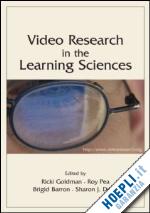Contents: R. Goldman, R. Pea, B. Barron,S.J. Derry, Preface.Part I:Theoretical Frameworks.R. Goldman, Video Representations & the Perspectivity Framework: Epistemology, Ethnography, Evaluation, and Ethics. J. Lemke,Video Epistemology In-and-Outside the Box: Traversing Attentional Spaces. F.V. Tochon,From Video Cases to Video Pedagogy: A Framework for Video Feedback and Reflection in Pedagogical Research Praxis.M.T. Hayes,Overwhelmed by the Image: The Role of Aesthetics in Ethnographic Filmmaking. J. Tobin, Y. Hsueh,The Poetics and Politics of Video Ethnography of Education. R. Spiro, B.P. Collins,A. Ramchandran,Reflections on a Post-Gutenberg Epistemology for Video Use in Ill-Structured Domains:Fostering Complex Learning and Cognitive Flexibility. S. Goldman,R. McDermott,Staying the Course With Video Analysis.J. Green, A. Skukauskaite, C. Dixon,R. Córdova, Epistemological Issues in the Analysis of Video Records: Interactional Ethnography as a Logic of Inquiry.T. Koschmann, G. Stahl,A. Zemel, The Video Analyst’s Manifesto (or The Implications of Garfinkel’s Policies for Studying Instructional Practice in Design-Based Research).F. Erickson, Ways of Seeing Video: Toward a Phenomenology of Viewing Minimally Edited Footage.PartII: Video Research on Peer, Family, and Informal Learning. B. Barron,Video as a Tool to Advance Understanding of Learning and Development in Peer, Family, and Other Informal Learning Contexts.C. Angelillo, B. Rogoff,P. Chavajay,Examining Shared Endeavors by Abstracting Video Coding Schemes With Fidelity to Cases. D. Ash, Using Video Data to Capture Discontinuous Science Meaning Making in Non-School Settings.M. Callanan, A. Valle,M. Azmitia,Expanding Studies of Family Conversations About Science Through Video Analysis.R.A. Engle, F.R. Conant,J.G. Greeno,Progressive Refinement of Hypotheses in Video-Supported Research.C.E. Hmelo-Silver, E. Katic, A. Nagarajan,E. Chernobilsky,Soft Leaders, Hard Artifacts, and the Groups We Rarely See: Using Video to Understand Peer Learning Processes.S.D. Palmquist,K. Crowley,Studying Dinosaur Learning on an Island of Expertise.D. vom Lehn,C. Heath, Social Interaction in Museums and Galleries: A Note on Video-Based Field Studies.PartIII:Video Research on Classroom and Teacher Learning. S.J. Derry,Video Research in Classroom and Teacher Learning (Standardize That!). K. Miller, Learning From Classroom Video: What Makes It Compelling and What Makes It Hard. D. Schwartz, K. Hartman, It's Not Video Anymore: Designing Digital Video for Learning and Assessment. M.W. Alibali,M.J. Nathan, Teachers' Gestures as a Means of Scaffolding Students’ Understanding: Evidence From an Early Algebra Lesson. W.-M. Roth, Epistemic Mediation: Video Data as Filters for the Objectification of Teaching by Teachers.M. Sherin, The Development of Teachers' Professional Vision in Video Clubs. D.H.P. Mace, T. Hatch,T. Iiyoshi, Teaching in and Teaching From the Classroom: Using Video and Other Media to Represent the Scholarship of Teaching and Learning. A.J. Petrosino,M.J. Koehler, Teachers as Designers: Pre- and In-Service Teachers Authoring of Anchor Video as a Means to Professional Development.PartIV:Video Collaboratories and Technological Futures. R. Pea,E. Hoffert,Video Workflow in the Learning Sciences: Prospects of Emerging Technologies for Augmenting Work Practices.R.M. Baecker, D. Fono,P. Wolf,Towards a Video Collaboratory.L. Beardsley, D. Cogan-Drew,F. Olivero,VideoPaper: Bridging Research and Practice for Pre-Service and Experienced Teachers.B.J. Fishman, Fostering Community Knowledge Sharing Using Ubiquitous Records of Practice.R. Goldman, Orion™, an Online Collaborative Digital Video Data Analysis Tool: Changing Our Perspectives as an Interpretive Community.K.E. Hay,B. Kim,Integrated Temporal Multimedia Data (ITMD) Research System.B. MacWhinney,A Transcript-Video Database for Collaborative Commentary in the Learning Sciences. R. Stevens,An Old Problem: Inert Ideas.R. Zaritsky,Creating an Educational Research Visualization: Using Visualizations as Scientific Warrants in the Earlier Research Phases.











